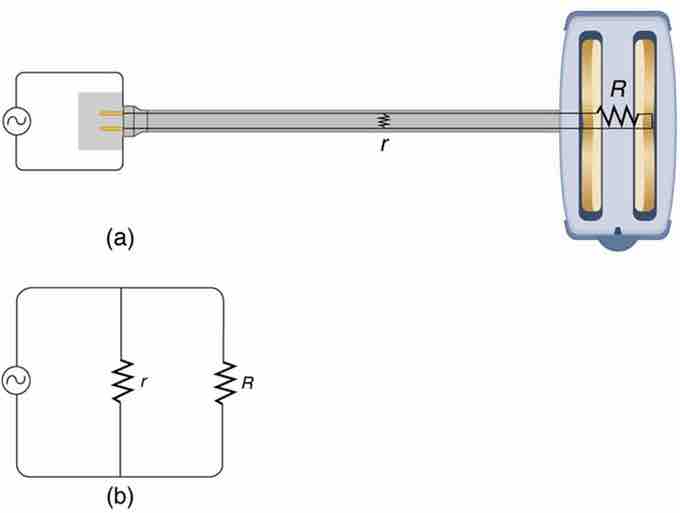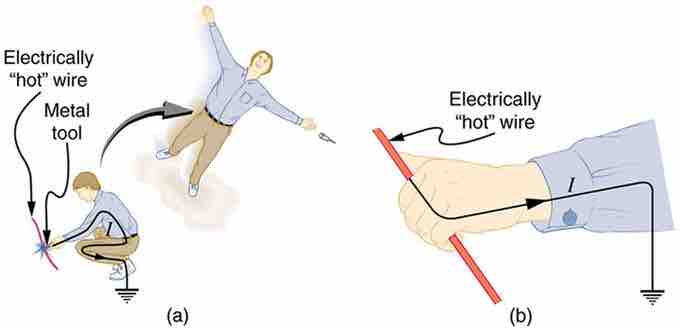There are two known categories of electrical hazards: thermal hazards and shock hazards. A thermal hazard is when excessive electric power causes undesired thermal effects, such as starting a fire in the wall of a house. A shock hazard occurs when electric current passes through a person. Shocks range in severity from painful but otherwise harmless to heart-stoppingly lethal.
Thermal Hazards
Electric power causes undesired heating effects whenever electric energy is converted to thermal energy at a rate faster than it can be safely dissipated. A classic example of this is the short circuit, shown in . A short circuit is a low-resistance path between terminals of a voltage source. Insulation on the appliance's wires has worn through, allowing the two wires to come into contact. Such an undesired contact with a high voltage is called a short. Since the resistance of the short, r, is very small, the power dissipated in the short, P = V2/r, is very large. For example, if V is 120 V and r is 0.100 Ω, then the power is 144 kW, much greater than that used by a typical household appliance. Thermal energy delivered at this rate will very quickly raise the temperature of surrounding materials, melting or perhaps igniting them.

Short Circuit
A short circuit is an undesired low-resistance path across a voltage source. (a) Worn insulation on the wires of a toaster allows them to come into contact with a low resistance r. Since P = V2/r, thermal power is created so rapidly that the cord melts or burns. (b) A schematic of the short circuit.
A thermal hazard can be created even when a short circuit is not present if the wires in a circuit are overloaded with too much current. The power dissipated in the supply wires is P = I2Rw, where Rw is the resistance of the wires and I the current flowing through them. If either I or Rw is too large, the wires overheat. Thermal hazards can cause moderate to severe burns to those who come in contact with the affected appliance or circuit.
Shock Hazards
Electric shock occurs upon contact of a body part with any source of electricity that causes a sufficient current through the skin, muscles, or hair. Typically, the expression is used to describe an injurious exposure to electricity.The minimum current a human can feel depends on the current type (AC or DC) and frequency. A person can feel at least 1 mA (rms) of AC current at 60 Hz and at least 5 mA of DC current. The current may, if it is high enough, cause tissue damage or fibrillation, which leads to cardiac arrest. 60 mA of AC (rms, 60 Hz) or 300-500 mA of DC can cause fibrillation.The potential severity of the shock depends on paths through the body that the currents take. If an electrical circuit is established by electrodes introduced in the body, bypassing the skin, then the potential for lethality is much higher if a circuit through the heart is established. This is known as a microshock. Currents of only 10 µA can be sufficient to cause fibrillation in this case.
A very dangerous possibility is the "can't let go" effect illustrated in . The muscles that close the fingers are stronger than those that open them, so the hand involuntarily closes around the wire shocking it. This can prolong the shock indefinitely. It can also be a danger to a person trying to rescue the victim, because the rescuer's hand may close about the victim's wrist. Usually the best way to help the victim is to give the fist a hard blow with an insulator or to throw an insulator at the fist.

Electric Shock and Muscular Contractions
An electric current can cause muscular contractions with varying effects. (a) The victim is "thrown" backward by involuntary muscle contractions that extend the legs and torso. (b) The victim can't let go of the wire that is stimulating all the muscles in the hand. Those that close the fingers are stronger than those that open them.
Factors in the Lethality of Electric Shock
The lethality of an electric shock is dependent on several variables:
- Current: The higher the current, the more likely it is lethal. Since current is proportional to voltage when resistance is fixed (Ohm's law), high voltage is an indirect risk for producing higher currents.
- Duration: The longer the duration, the more likely it is lethal -- safety switches may limit the time of current flow.
- Pathway: If current flows through the heart muscle, it is more likely to be lethal.
- Very high voltage (over about 600 volts): This poses an additional risk beyond the simple ability of high voltage to cause high current at a fixed resistance. Very high voltage, enough to cause burns, will cause dielectric breakdown at the skin, actually lowering total body resistance and, ultimately, causing even higher current than when the voltage was first applied. Contact with voltages over 600 volts can cause enough skin burning to decrease the total resistance of a path though the body to 500 ohms or less.
- Frequency: Very high-frequency electric current causes tissue burning but does not penetrate the body far enough to cause cardiac arrest.

High Voltage Warning
International safety symbol "Caution, risk of electric shock" (ISO 3864), also known as the high-voltage symbol